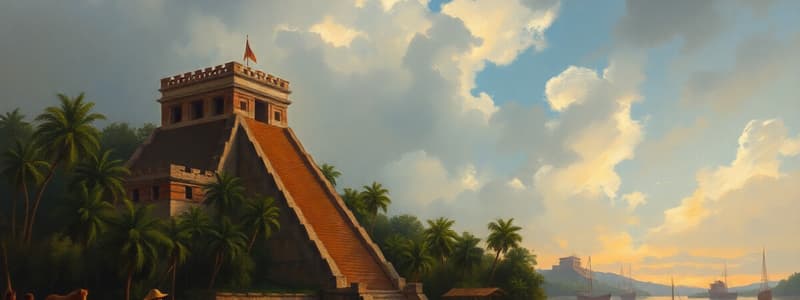Podcast
Questions and Answers
The Mayan Civilization primarily occupied regions in modern-day southeastern Mexico, Guatemala, and Belize.
The Mayan Civilization primarily occupied regions in modern-day southeastern Mexico, Guatemala, and Belize.
True (A)
The Spanish Conquest began in the 18th century and had no impact on indigenous populations.
The Spanish Conquest began in the 18th century and had no impact on indigenous populations.
False (B)
The Panama Canal is strategically significant for trade routes between North and South America.
The Panama Canal is strategically significant for trade routes between North and South America.
True (A)
Spanish is the only language spoken in Central America.
Spanish is the only language spoken in Central America.
Signup and view all the answers
Central America is known for its rich biodiversity and variety of ecosystems.
Central America is known for its rich biodiversity and variety of ecosystems.
Signup and view all the answers
Study Notes
Mayan Civilization
- Location: Primarily in modern-day southeastern Mexico, Guatemala, Belize, and western Honduras.
- Timeline: Flourished from around 2000 BCE to the arrival of Spanish conquistadors in the 16th century.
-
Achievements:
- Advanced writing system (hieroglyphics).
- Mathematical innovations, including the concept of zero.
- Remarkable advancements in astronomy (calendar systems).
- Architectural feats (pyramids, palaces, ceremonial centers).
- Society: City-states ruled by kings, with a polytheistic religion and a complex social hierarchy.
- Decline: Factors include environmental degradation, warfare, and drought.
Colonial History
- Spanish Conquest: Began in the early 16th century, led by figures such as Hernán Cortés and Pedro de Alvarado.
- Colonization: Establishment of Spanish colonial rule; introduction of encomienda systems.
- Impact on Indigenous Populations: Significant decline due to disease, warfare, and slavery.
- Independence Movements: Early 19th century upheavals led to the independence of Central American nations between 1821-1838, often influenced by broader Latin American independence movements.
- Geo-political Changes: Formation of provinces and later the United Provinces of Central America before fragmentation into individual nation-states.
Geopolitical Significance
- Strategic Location: Acts as a bridge between North and South America; important for trade routes.
- Panama Canal: Vital for maritime trade, affecting global shipping and trade policies.
- US Influence: Historical interventions from the US, particularly during the Cold War, with military, economic, and political involvement.
- Regional Cooperation: Efforts such as the Central American Integration System (SICA) to foster economic and political collaboration among countries.
Cultural Diversity
- Ethnic Composition: A mix of indigenous peoples, mestizos, Afro-descendants, and Europeans.
- Languages: Spanish is predominant, but numerous indigenous languages are spoken, including K'iche', Q'eqchi', and Garifuna.
- Cultural Practices: Rich traditions in music, dance, art, and gastronomy, reflecting indigenous, African, and European influences.
- Religious Beliefs: Predominantly Roman Catholic with syncretic elements from indigenous religions and African traditions.
Natural Resources
- Biodiversity: Rich ecosystems and species diversity; vital for global ecological health.
- Agricultural Products: Major exporter of coffee, bananas, sugar, and cocoa.
- Mining: Rich in minerals like gold, silver, and nickel; mining impacts on environment and local communities.
- Forestry: Tropical rainforests provide timber and are crucial for conservation efforts, facing pressure from deforestation.
Mayan Civilization
- Flourished in modern-day southeastern Mexico, Guatemala, Belize, and western Honduras between 2000 BCE and the 16th century
- Developed a complex writing system (hieroglyphics), advanced mathematics (including concept of zero), sophisticated astronomy (calendar systems), and remarkable architecture (pyramids, palaces, ceremonial centers)
- Society was organized around city-states ruled by kings, with a polytheistic religion and a complex social hierarchy
- The decline of the Mayan civilization is attributed to factors such as environmental degradation, warfare, and drought
Colonial History
- Spanish conquest began in the early 16th century, led by figures like Hernán Cortés and Pedro de Alvarado.
- Spanish rule established the encomienda system, which exploited indigenous populations and caused a significant decline due to disease, warfare, and slavery
- Independence movements in the early 19th century (influenced by broader Latin American independence movements) led to the independence of Central American nations between 1821-1838.
- The region experienced changes from provinces to the United Provinces of Central America before fragmenting into individual nation-states
Geopolitical Significance
- Central America is strategically located as a bridge between North and South America, playing a role in trade routes
- The Panama Canal is a vital passage for maritime trade, impacting global shipping and trade policies
- The US has historically intervened in Central America, especially during the Cold War, with military, economic, and political involvement
- Regional cooperation efforts, such as the Central American Integration System (SICA), aim to foster economic and political collaboration among Central American countries
Cultural Diversity
- The region is ethnically diverse, encompassing indigenous peoples, mestizos, Afro-descendants, and Europeans
- While Spanish is predominant, many indigenous languages are spoken, including K'iche', Q'eqchi', and Garifuna
- The region boasts rich cultural traditions in music, dance, art, and gastronomy, reflecting indigenous, African, and European influences
- Religiously, the region is predominantly Roman Catholic with syncretic elements from indigenous religions and African traditions
Natural Resources
- Central America has rich ecosystems and biodiversity, important for global ecological health
- The region is a major exporter of agricultural products like coffee, bananas, sugar, and cocoa
- The region has mineral resources like gold, silver, and nickel, but mining impacts the environment and local communities
- The region's tropical rainforests provide timber and are crucial for conservation efforts, facing pressure from deforestation.
Studying That Suits You
Use AI to generate personalized quizzes and flashcards to suit your learning preferences.
Description
Test your knowledge on the Mayan Civilization's achievements, timeline, and societal structure. Explore the impact of Spanish conquest and colonization on indigenous populations. This quiz covers key historical events and cultural aspects of this fascinating period.




